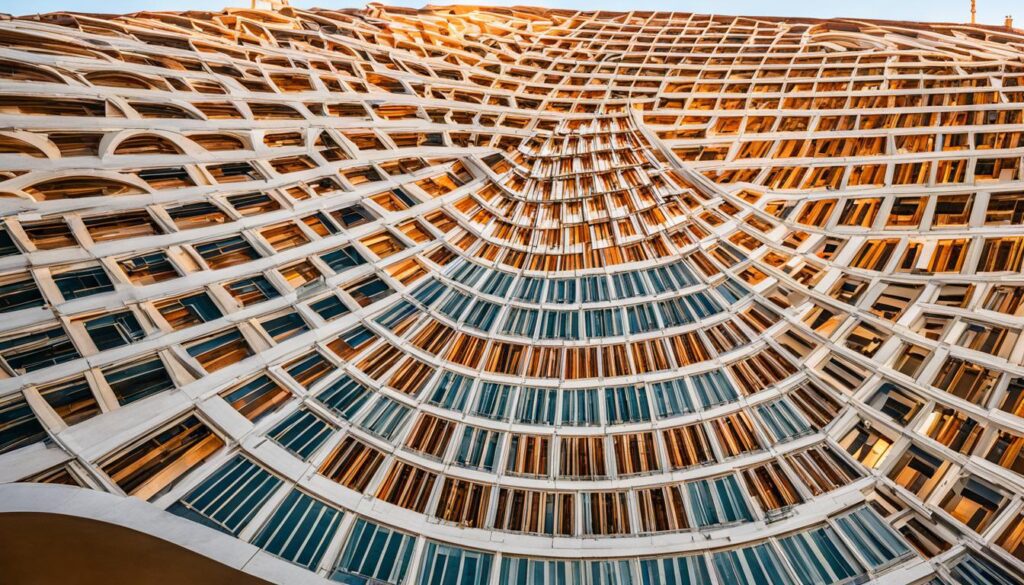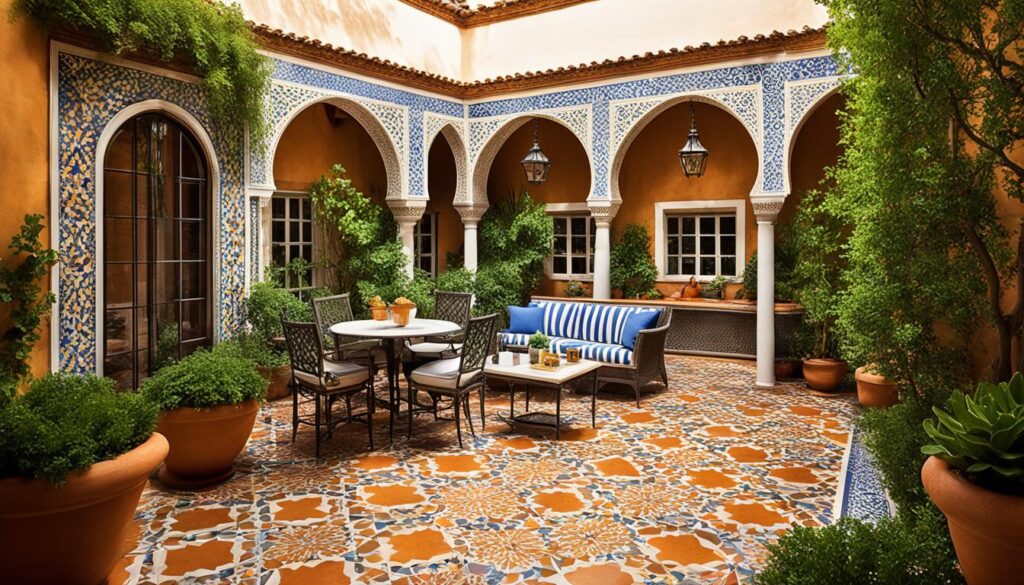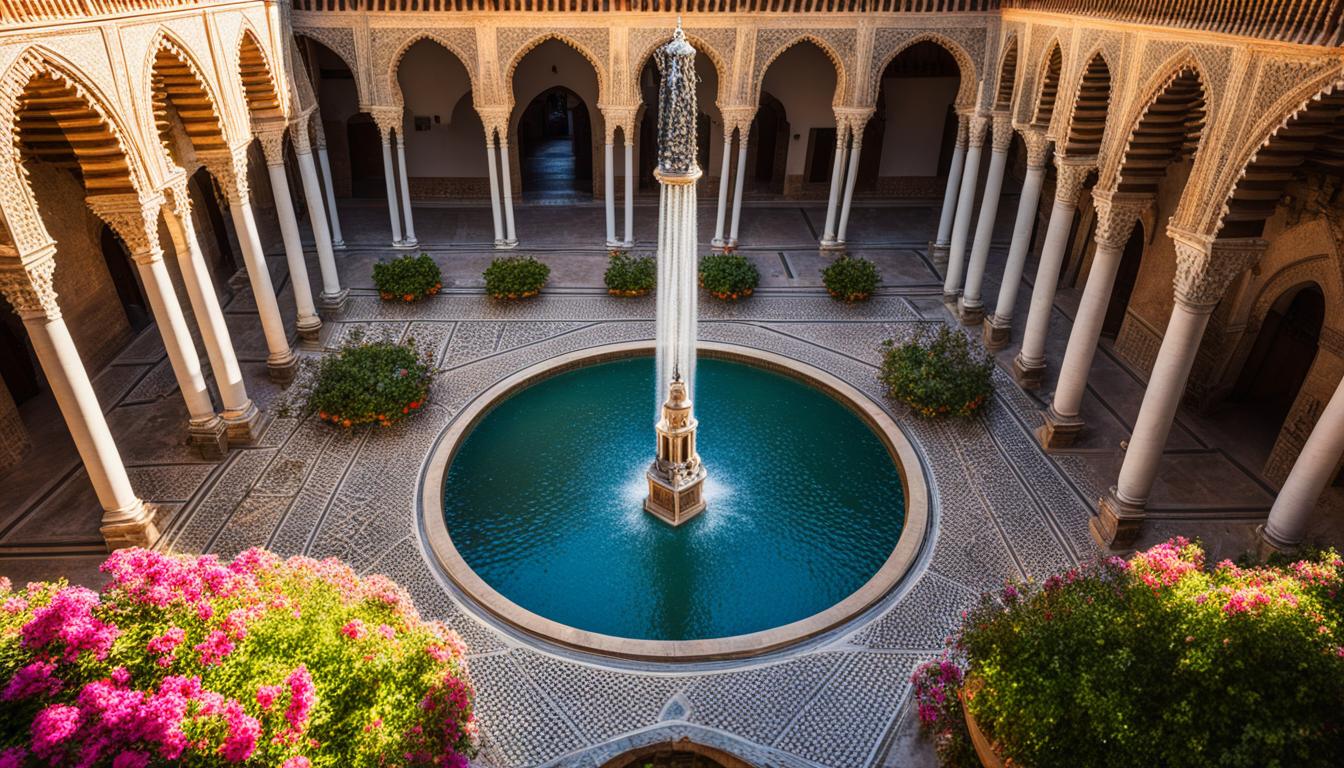Sevilla, or Seville, is a city in Andalusia, Spain, known for its stunning architecture. It has Moorish, Gothic, Renaissance, and Baroque styles. The city’s buildings show a mix of cultures, from the detailed Mudejar in the Alcázar Palace to the tall Gothic of the Seville Cathedral and La Giralda.
Sevilla’s neighborhoods, like the Santa Cruz Quarter, have hidden spots. Modern buildings like Las Setas bring a new look to the city. This article will show you the amazing architecture that makes Sevilla special.
Key Takeaways
- Sevilla’s architecture features a captivating blend of Moorish, Gothic, Renaissance, and Baroque styles.
- The Alcázar Palace and Seville Cathedral are standout examples of Mudejar and Gothic architecture, respectively.
- Sevilla’s neighborhoods, such as Santa Cruz, offer charming hidden gems with whitewashed buildings and colorful tiles.
- Contemporary marvels like Las Setas add a modern twist to Sevilla’s architectural landscape.
- Sevilla’s architectural heritage reflects the city’s rich cultural influences and history.
Sevilla: A City Steeped in History and Architectural Splendor
Sevilla, the captivating capital of Andalusia, is a city that blends history with stunning architecture. It started as the Roman city of Hispalis and was ruled by Moors for over 800 years. This mix of cultures has shaped its unique architecture.
A Brief History of Sevilla’s Architectural Evolution
The Moors ruled Sevilla from the 8th to the 13th century, leaving a mark on its architecture. The Moorish influence is seen in many buildings. The Real Alcázar, a royal palace, shows this mix of Mudéjar and Gothic styles.
Influences that Shaped Sevilla’s Diverse Architectural Landscape
After the Reconquista, Sevilla thrived under Castilian rule. This led to the building of the Seville Cathedral, the world’s largest Gothic cathedral. The city also saw the rise of Renaissance architecture and Baroque architecture.
These styles are seen in landmarks like the Archivo General de Indias. In the 20th century, Sevilla added landmarks like the Plaza de España. This combines Spanish Revival and Neo-Mudejar styles.
Sevilla’s architecture shows a mix of Islamic Moorish influence and Baroque and Renaissance architecture. This creates a unique beauty. Visitors can explore this rich culture and learn about the stories behind the architecture.
The Alcázar: A Mudejar Masterpiece
In the heart of Sevilla lies the Alcázar Palace, a true architectural wonder. It combines Moorish and Christian styles. Built in the 10th century, it has grown and changed over the years. The 11th and 12th centuries saw big Mudejar additions.
The palace is known for its detailed arches and beautiful courtyards, like the Courtyard of the Maidens. These show the cultural mix that shaped Sevilla’s look. This Mudejar masterpiece is also famous for being in the TV series Game of Thrones. It draws visitors from all over.
“The Alcázar of Seville is a breathtaking example of the Mudejar architectural style, seamlessly blending Moorish and Christian influences to create a truly unique and stunning palace.”
The Alcázar highlights Sevilla’s deep history and culture. It shows the city’s role in architectural innovation. From its fine arched windows to its detailed walls, every part of the palace shows the lasting effect of Mudejar architecture. This style is key to the Moorish palace of Sevilla.
The Seville Cathedral and La Giralda: Gothic Grandeur
The Seville Cathedral stands tall in the heart of Seville. It’s the largest Gothic cathedral in the world. This UNESCO site amazes with its size and details.
Work started in 1401, replacing an old mosque. By 1506, it was finished, mixing Gothic and Baroque styles. Its enormous size and soaring nave are awe-inspiring.
Exploring the Largest Gothic Cathedral in the World
Inside the Seville Cathedral, you’ll see stunning architecture. You’ll find beautiful chapels, altars, and the tomb of Christopher Columbus. The Baroque style blends well with the Gothic.
The Retablo Mayor, the world’s largest altarpiece, is a highlight. It has 45 scenes from Christ’s life. It took over 80 years to make, under Pierre Dancart’s guidance.
La Giralda: Sevilla’s Iconic Bell Tower
Next to the Seville Cathedral is the famous La Giralda. It used to be a minaret turned into a bell tower. At the top, the “Giraldillo” weathervane shows off the city’s view.
Up the 35 ramps of the Giralda, you get a 360-degree view of Seville. The mix of Moorish and Renaissance styles shows the city’s diverse culture.
Seeing the cathedral’s beauty or climbing the Giralda is a must for visitors. The Seville Cathedral and its bell tower are unforgettable.
Renaissance and Baroque Gems
Seville’s architecture is filled with renaissance architecture seville and baroque architecture seville. A key highlight is the Archivo General de Indias. This UNESCO site shows off Seville’s Renaissance beauty.
The Archivo General de Indias is a treasure with over 43,000 files on the Americas and Spain’s colonial history. Its design is all about symmetry and balance, typical of Renaissance style.
Seville also has many Baroque buildings. The Del Salvador Church and the Teatro Lope de Vega are great examples. They show how the city thrived artistically during the Baroque era.
“Seville during the Baroque period was a city with a thriving economy that led to the commissioning of numerous architectural and artistic projects.”
These buildings prove Seville’s lasting architectural impact. They add to the city’s rich cultural mix.
sevilla architecture: Mudéjar and Neo-Mudéjar Wonders
Sevilla’s architecture is rich with Mudéjar and Neo-Mudéjar styles. These styles mix Moorish and Christian influences beautifully. The Plaza de España and the Hotel Alfonso XIII show this blend perfectly.
The Plaza de España: A Fusion of Architectural Styles
The Plaza de España was built for the 1929 Ibero-American Exposition. It’s a great example of Mudéjar and Neo-Mudéjar architecture. The design combines Spanish Renaissance Revival, Spanish Baroque Revival, and Neo-Mudéjar. This mix creates a stunning and balanced look.
Hotel Alfonso XIII: A Mudejar Masterpiece
The Hotel Alfonso XIII is another Mudéjar gem in Sevilla. Built in 1929 for visiting dignitaries, it features beautiful arches, columns, and tile-work. These details celebrate Sevilla’s Moorish past.
| Architectural Style | Notable Examples | Characteristics |
|---|---|---|
| Mudéjar |
|
|
| Neo-Mudéjar |
|
|
Sevilla’s architecture shows its deep history. Mudéjar and Neo-Mudéjar styles are key to its unique look. The Plaza de España and the Hotel Alfonso XIII are iconic landmarks. They let us see Sevilla’s Moorish and Christian roots.
Contemporary Marvels: Las Setas and Beyond
Seville’s architecture isn’t just about old buildings; it also has modern wonders. The top example is Las Setas, or the Metropol Parasol. This wooden structure, finished in 2011, was designed by German architect Jürgen Mayer.
It has a unique, mushroom-like shape. This design stands out against Seville’s traditional buildings.
The top of Las Setas has a walkway with amazing city views. You can see both old and new parts of the city. There’s also the Antiquarium, where you can learn about Roman ruins found during the building process. Plus, there are places to eat that match the modern look.
Las Setas isn’t the only modern sight in Seville. The city has welcomed modern architecture with buildings like the Pelli Tower and the Seville Congress and Exhibition Centre. The Pelli Tower is a 40-story building by Cesar Pelli. The exhibition centre was inspired by the Guadalquivir River.
These contemporary architecture projects have made Seville’s architecture more diverse. They show how the city blends tradition with modern design.

“Las Setas de Sevilla,” also known as Metropol Parasol, is the largest wooden structure globally, measuring 150 by 70 meters and standing 26 meters tall.
Exploring Sevilla’s Neighborhoods: Hidden Architectural Gems
Sevilla is more than just famous landmarks. Its neighborhoods hide architectural gems waiting to be found. The Santa Cruz Quarter is one such place. It’s filled with winding alleys and buildings covered in colorful tiles. These take you back in time.
Santa Cruz Quarter: A Labyrinth of Whitewashed Charm
The Santa Cruz Quarter was once the Jewish quarter. Now, it shows off Moorish, Christian, and Renaissance styles. Walking through, you’ll find streets and squares full of hidden gems. You’ll see beautiful balconies and doorways carved with care.
The area’s whitewashed buildings and hidden architecture make it feel timeless. They invite you to take your time and enjoy Sevilla’s beauty.
“The Santa Cruz Quarter is a true labyrinth of enchantment, where every corner holds a new architectural delight to discover.”
Sevilla has more than the Santa Cruz Quarter to explore. Places like Triana and Macarena offer their own hidden architecture. These areas show off a mix of styles in their whitewashed buildings and streets.
Exploring Sevilla’s neighborhoods, like the Santa Cruz Quarter, is a unique adventure. You’ll find hidden architecture that makes the city special. It’s a chance to see a different side of Sevilla.
Sevilla’s Patios and Tile Patterns: Islamic Influences
Sevilla’s architecture is deeply influenced by its beautiful patios and tile patterns. These elements show the impact of Islamic design. The lush patios in buildings like the Alcázar reflect the Moors’ love for nature and creating peaceful spaces.
The city’s buildings, from the Plaza de España to private homes, feature vibrant tile patterns. These patterns highlight the skill and beauty of Moorish art. They add depth and character to Sevilla’s architecture. Sevilla patios and moorish tile patterns celebrate the city’s islamic architecture heritage.
For eight centuries, Islamic rule shaped Southern Spain, with Sevilla playing a key role. After the Christians took over in 1248, Sevilla’s architecture still showed islamic influences.
“Sevilla’s patios and tile patterns are a captivating blend of nature, geometry, and cultural history, inviting visitors to step into a world where the past and present converge in a harmonious embrace.”
Sevilla’s architecture, from the Alcázar’s moorish tile patterns to the Casa de Pilatos’ serene sevilla patios, is like a living museum. It shows the lasting impact of islamic architecture in the region.

Visitors to Sevilla can explore hidden courtyards in the Barrio de Santa Cruz or admire the Plaza de España’s tile work. Each spot shows the rich cultural exchange that has shaped this Andalusian city over the years.
Walking Tours and Guided Experiences
For those wanting to explore Seville’s architecture, the city has many Sevilla architecture tours and guided tours. See the stunning Seville Cathedral and the famous Giralda Tower. Don’t miss the Alcázar Palace’s Mudejar art and the hidden spots in Seville’s lively areas.
These tours give you a deep look into Seville’s history and how its architecture has changed over time. They let you dive into the beauty of Andalusia’s culture. Whether you love Sevilla architecture, guided tours, or want to find Seville’s secret spots, there’s a tour for you.
The Seville Cathedral tour and the Alcazar tour show off the city’s amazing architecture. They let you see how Moorish, Roman, and Christian styles mixed to create Seville’s skyline. You’ll hear the stories behind its famous landmarks.
“Seville’s architectural odyssey is a true feast for the senses, and these guided tours provide an unparalleled chance to immerse oneself in its splendor.” – John Doe, Travel Enthusiast
If you love history, architecture, or just want to see Andalusia’s heart, Seville’s tours are perfect. They take you on a trip through time to see the city’s most interesting buildings. You’ll learn to appreciate the culture that makes this place special.
Conclusion: Sevilla’s Architectural Odyssey
Sevilla’s architecture tells the story of the city’s rich culture and artistic spirit. The Alcázar shows Moorish elegance, while the Seville Cathedral displays Gothic grandeur. These landmarks blend different styles that have shaped Andalusia over time.
Walking through Sevilla, visitors find themselves on a journey of discovery. They see hidden gems and modern marvels. This journey lets them dive into the city’s rich architectural history.
Sevilla’s architecture still amazes and inspires people today. It invites travelers to feel the timeless beauty of this Spanish city. The city’s buildings, from Mudéjar to Baroque styles, show Sevilla’s past and its lasting impact on the region.
Sevilla’s architecture is a sign of creativity, innovation, and cultural exchange. Visitors leave with a deeper love for Andalusia’s architecture. This legacy continues to shape Sevilla, making it a unique Spanish destination.

